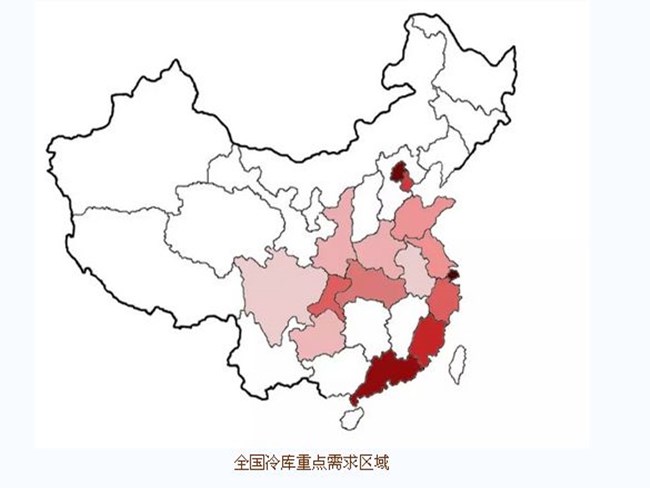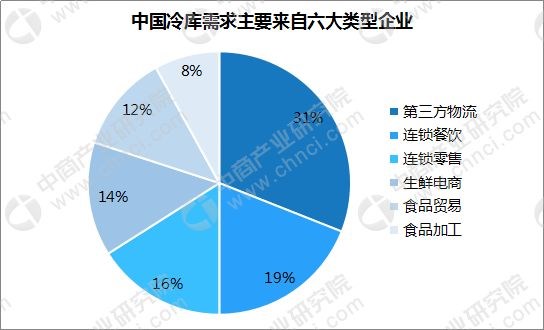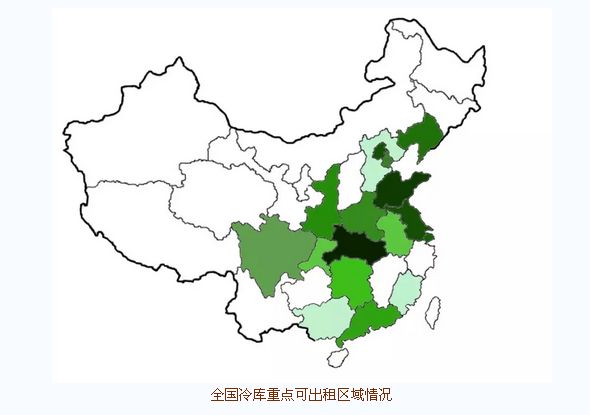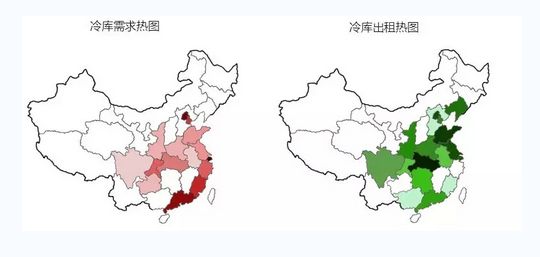- 2020中國冷庫制造行業(yè)市場分析與展望。
- 本站編輯:杭州克冷制冷設(shè)備有限公司發(fā)布日期:2020-08-07 15:57 瀏覽次數(shù):

冷庫是冷鏈物流行業(yè)中重要的基礎(chǔ)設(shè)施之一。近年來,我國冷庫保有量有所提高,但相較于龐大的市場需求仍不足。據(jù)中物聯(lián)數(shù)據(jù)顯示,2018上半年全國冷庫需求超過150萬平米,同比增長14.9%。目前,國內(nèi)冷庫需求主要集中在北上廣深,以及福建、天津、浙江、江蘇、山東、重慶、河南等地。
Cold storage is one of the important infrastructures in the cold chain logistics industry. In recent years, the amount of cold storage in China has increased, but it is still insufficient compared with the huge market demand. China's demand for cold storage in the first half of 2018 exceeded 1.5 million square meters, up 14.9 percent year on year, according to the China Federation of Materials Industry. At present, domestic cold storage demand is mainly concentrated in The north, Shanghai, Guangzhou and Shenzhen, as well as Fujian, Tianjin, Zhejiang, Jiangsu, Shandong, Chongqing, Henan and other places.
Cold storage is one of the important infrastructures in the cold chain logistics industry. In recent years, the amount of cold storage in China has increased, but it is still insufficient compared with the huge market demand. China's demand for cold storage in the first half of 2018 exceeded 1.5 million square meters, up 14.9 percent year on year, according to the China Federation of Materials Industry. At present, domestic cold storage demand is mainly concentrated in The north, Shanghai, Guangzhou and Shenzhen, as well as Fujian, Tianjin, Zhejiang, Jiangsu, Shandong, Chongqing, Henan and other places.

冷庫作為冷鏈物流中保鮮儲藏環(huán)節(jié)的重要工具,關(guān)系到多個細(xì)分市場領(lǐng)域。其中,第三方物流企業(yè)多冷庫需求最大,而食品加工企業(yè)需求最小。
As an important tool of fresh-keeping in cold chain logistics, cold storage is related to many market segments. Among them, the third party logistics enterprises have the largest demand for multi-cold storage, while the food processing enterprises have the smallest demand.
As an important tool of fresh-keeping in cold chain logistics, cold storage is related to many market segments. Among them, the third party logistics enterprises have the largest demand for multi-cold storage, while the food processing enterprises have the smallest demand.

上圖中六個領(lǐng)域中的企業(yè)對冷庫需求較大,它們的冷庫需求主要因?yàn)椋阂皇怯捎跇I(yè)務(wù)異地?cái)U(kuò)張,需要新的分撥倉;二是現(xiàn)租冷庫合同到期或即將拆遷;三是季節(jié)性業(yè)務(wù)需求,臨時需要冷庫進(jìn)行周轉(zhuǎn);四是出現(xiàn)新的入局者,重點(diǎn)城市需要冷庫網(wǎng)點(diǎn)支撐。冷庫需求日益增長,而冷庫租賃市場的集中領(lǐng)域與需求集中領(lǐng)域相近。據(jù)不完全統(tǒng)計(jì),2018上半年全國冷庫可出租面積超過330萬平米,同比增長12.1%。出租冷庫范圍主要集中在北上廣深,以及湖北、山東、江蘇、遼寧、山東、河南等地。
Enterprises in the six fields in the figure above have a great demand for cold storage, which is mainly due to the following reasons: 1. Second, the current lease cold storage contract expires or is about to be demolished; Third, seasonal business needs, temporary need for cold storage turnover; Fourth, the emergence of new entrants, key cities need cold storage network support. The demand for cold storage is increasing day by day, and the focus area of the cold storage rental market is similar to the focus area of the demand. According to incomplete statistics, in the first half of 2018, the lettable refrigerated storage area in China exceeded 3.3 million square meters, up 12.1 percent year on year. The rental scope of cold storage is mainly concentrated in Beijing, Shanghai, Guangzhou and Shenzhen, as well as Hubei, Shandong, Jiangsu, Liaoning, Shandong, Henan and other places.
Enterprises in the six fields in the figure above have a great demand for cold storage, which is mainly due to the following reasons: 1. Second, the current lease cold storage contract expires or is about to be demolished; Third, seasonal business needs, temporary need for cold storage turnover; Fourth, the emergence of new entrants, key cities need cold storage network support. The demand for cold storage is increasing day by day, and the focus area of the cold storage rental market is similar to the focus area of the demand. According to incomplete statistics, in the first half of 2018, the lettable refrigerated storage area in China exceeded 3.3 million square meters, up 12.1 percent year on year. The rental scope of cold storage is mainly concentrated in Beijing, Shanghai, Guangzhou and Shenzhen, as well as Hubei, Shandong, Jiangsu, Liaoning, Shandong, Henan and other places.

通過冷庫需求熱圖和冷庫出租熱圖對比,可以看出國內(nèi)冷庫供需格局有以下特點(diǎn):供需北上廣等城市供需兩旺。福建、浙江、貴州、河南等地需求旺盛且冷庫存量不足。這些主要為二線省會城市,將面臨新一輪經(jīng)濟(jì)的快速發(fā)展和消費(fèi)升級,未來冷庫市場將進(jìn)一步擴(kuò)大。
By comparing the heat map of cold storage demand with the heat map of cold storage rental, it can be seen that the domestic cold storage supply and demand pattern has the following characteristics: supply and demand are flourishing in cities such as Beijing, Shanghai and Guangzhou. Fujian, Zhejiang, Guizhou, Henan and other places with strong demand and cold storage inventory shortage. These are mainly second-tier provincial capitals, which will face a new round of rapid economic development and consumption upgrading, and the cold storage market will be further expanded in the future.
By comparing the heat map of cold storage demand with the heat map of cold storage rental, it can be seen that the domestic cold storage supply and demand pattern has the following characteristics: supply and demand are flourishing in cities such as Beijing, Shanghai and Guangzhou. Fujian, Zhejiang, Guizhou, Henan and other places with strong demand and cold storage inventory shortage. These are mainly second-tier provincial capitals, which will face a new round of rapid economic development and consumption upgrading, and the cold storage market will be further expanded in the future.
湖北、湖南、山東等省市冷庫相對過剩。首先在冷庫的經(jīng)營方面,要找準(zhǔn)定位做到差異化。其次冷庫過剩不僅僅是因?yàn)樾枨笊?,也可能是因?yàn)槔鋷毂旧頋M足不了需求。價格北京獨(dú)一檔最高價。北京冷庫本來就相對緊缺,加上去年底開始的持續(xù)對非合規(guī)資質(zhì)冷庫的整頓關(guān)停,導(dǎo)致北京冷庫資源緊俏,價格自然水漲船高;上海、南京、廣州、深圳、???、昆明等地冷庫價格相對較高。其中前四個屬于典型的一線或準(zhǔn)一線消費(fèi)城市,隨著政策環(huán)境趨緊,冷庫價格將進(jìn)一步上漲。后兩個城市由于自然氣候以及產(chǎn)地屬性等因素,冷庫價格也趨于高位。大部分城市波幅不大,供需平衡。
Hubei, Hunan, Shandong and other provinces and cities cold storage relative surplus. First of all, in the operation of cold storage, we must find the correct positioning to achieve differentiation. Secondly, the surplus of cold storage is not only because the demand is low, but also because the cold storage itself cannot meet the demand. The price is the highest in Beijing. Beijing's cold storage is already relatively short, coupled with the continuous rectification and closure of non-compliant cold storage since the end of last year, leading to a shortage of cold storage resources in Beijing and a natural rise in prices; Shanghai, Nanjing, Guangzhou, Shenzhen, Haikou, Kunming and other places refrigeration prices are relatively high. The first four of them are typical first-tier or quasi-first-tier consumer cities. As the policy environment becomes tighter, the price of cold storage will rise further. The latter two cities due to natural climate and origin attributes and other factors, cold storage prices tend to high. In most cities, the fluctuation is small and supply and demand balance.
Hubei, Hunan, Shandong and other provinces and cities cold storage relative surplus. First of all, in the operation of cold storage, we must find the correct positioning to achieve differentiation. Secondly, the surplus of cold storage is not only because the demand is low, but also because the cold storage itself cannot meet the demand. The price is the highest in Beijing. Beijing's cold storage is already relatively short, coupled with the continuous rectification and closure of non-compliant cold storage since the end of last year, leading to a shortage of cold storage resources in Beijing and a natural rise in prices; Shanghai, Nanjing, Guangzhou, Shenzhen, Haikou, Kunming and other places refrigeration prices are relatively high. The first four of them are typical first-tier or quasi-first-tier consumer cities. As the policy environment becomes tighter, the price of cold storage will rise further. The latter two cities due to natural climate and origin attributes and other factors, cold storage prices tend to high. In most cities, the fluctuation is small and supply and demand balance.

價格都在2.5-3元之間,但像杭州、天津、成都、重慶等城市,隨著需求的增加,冷庫價格有上漲空間。少部分城市冷庫價格不高。例如像銀川、呼市、太原等,主要原因是消費(fèi)升級速度相對較慢,經(jīng)濟(jì)水平一般,冷庫市場不規(guī)范造成的。更多材料及分析均來自中商產(chǎn)業(yè)研究院發(fā)布的《2018-2023年中國冷庫市場前景及投資機(jī)會研究報告》。
Prices are between 2.5-3 yuan, but in cities such as Hangzhou, Tianjin, Chengdu and Chongqing, with the increase in demand, the refrigerated storage price has room to rise. The price of cold storage in a few cities is not high. For example, in Yinchuan, Hushi, Taiyuan and other cities, the main reasons are relatively slow consumption upgrade speed, general economic level, and non-standard cold storage market. More materials and analysis are from the research Report on cold storage Market Prospects and Investment Opportunities in China 2018-2023 released by China Academy of Commerce.
Prices are between 2.5-3 yuan, but in cities such as Hangzhou, Tianjin, Chengdu and Chongqing, with the increase in demand, the refrigerated storage price has room to rise. The price of cold storage in a few cities is not high. For example, in Yinchuan, Hushi, Taiyuan and other cities, the main reasons are relatively slow consumption upgrade speed, general economic level, and non-standard cold storage market. More materials and analysis are from the research Report on cold storage Market Prospects and Investment Opportunities in China 2018-2023 released by China Academy of Commerce.











